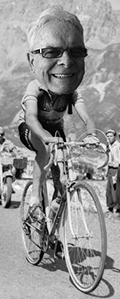Major Taylor 1878 - 1932
 Mon, February 10, 2020
Mon, February 10, 2020  February being Black History Month, I wanted to remind everyone of this remarkable athlete.
February being Black History Month, I wanted to remind everyone of this remarkable athlete.
Marshall Walter ("Major") Taylor born in Indianapolis, Indiana was an African American cyclist who won the World One-mile Track Cycling Championship in 1899, 1900, and 1901.
Major Taylor was the second black world champion in any sport, after Canadian boxer George Dixon.
The Major Taylor Velodrome in Indianapolis, Indiana and a bicycle trail in Chicago are named in his honor.
On July 24, 2006 the city of Worcester, MA changed the name of part of Worcester Center Boulevard to Major Taylor Boulevard.
 Memorial outside the Worcester Public Library in his adopted hometown of Worcester, Massachusetts
Memorial outside the Worcester Public Library in his adopted hometown of Worcester, Massachusetts
Major Taylor suffered as a result of racial prejudice throughout his career, banned from racing by some promoters, or treated roughly or unfairly by other competitors. The League of American Wheelmen banned black cyclists form membership in 1894.

(Left.) A caricature published in the edition of February 23, 1894 of The Bearings cycling magazine, illustrating the ban from membership of the League of American Wheelmen
However, by competing in an integrated sport, and even being part of an integrated team, Major Taylor paved the way for other black athletes in other sports.
 Taylor shakes the hand of competitor Edmond Jacquelin at Paris' Parc des Princes Velodrome in 1901
Taylor shakes the hand of competitor Edmond Jacquelin at Paris' Parc des Princes Velodrome in 1901
 Taylor and Léon Hourlier at a standstill during a race at Paris' Vélodrome Buffalo in 1909
Taylor and Léon Hourlier at a standstill during a race at Paris' Vélodrome Buffalo in 1909
 Taylor with the Boston pursuit team of 1897; one of the first known photographs of an integrated American professional sports team.
Taylor with the Boston pursuit team of 1897; one of the first known photographs of an integrated American professional sports team.
Here are some links to more on Major Taylor:
MajorTaylor.com
The Major Taylor Association
Wikipedia




















Reader Comments (7)
I was living in Indy when the Taylor Velodrome was built (for a pre-Olympic event, it has also hosted a Pan-American Games and many US championships). His name was well known and well respected, at least among area cyclists.
I even had a chance to ride on it a few times (outdoor, concrete, 333.3m).
Thanks for giving him mention here Dave.
thank you, Dave! impressive what he did in those hard hard times. best regards, Mircea
Thanks Dave for the post. Through Major Taylor's achievements, he brought out the best in the few who helped him and those who competed with him as an equal. Unfortunately it also highlited the disturbing racism of the time within and outside the cycling community. As I bike with my own local club rides and look around at the lack of diversity, it makes believe that we still need to do more to lower the real and/or perceived barriers. Mike
Dave, do you have the source for those two photos of Major on the track?
RGT,
All the pictures are from the Wikipedia site, there is a link at the end of the article. When on the Wiki site, click on a picture to see an enlarged image.
Dave
Explaining the thought behind those slack frame angles and long chainstays might make an interesting blog entry...
Brian,
I covered that in this article"
http://davesbikeblog.squarespace.com/blog/2014/11/24/the-bicycle-evolution-or-intelligent-design-part-i.html
Dave